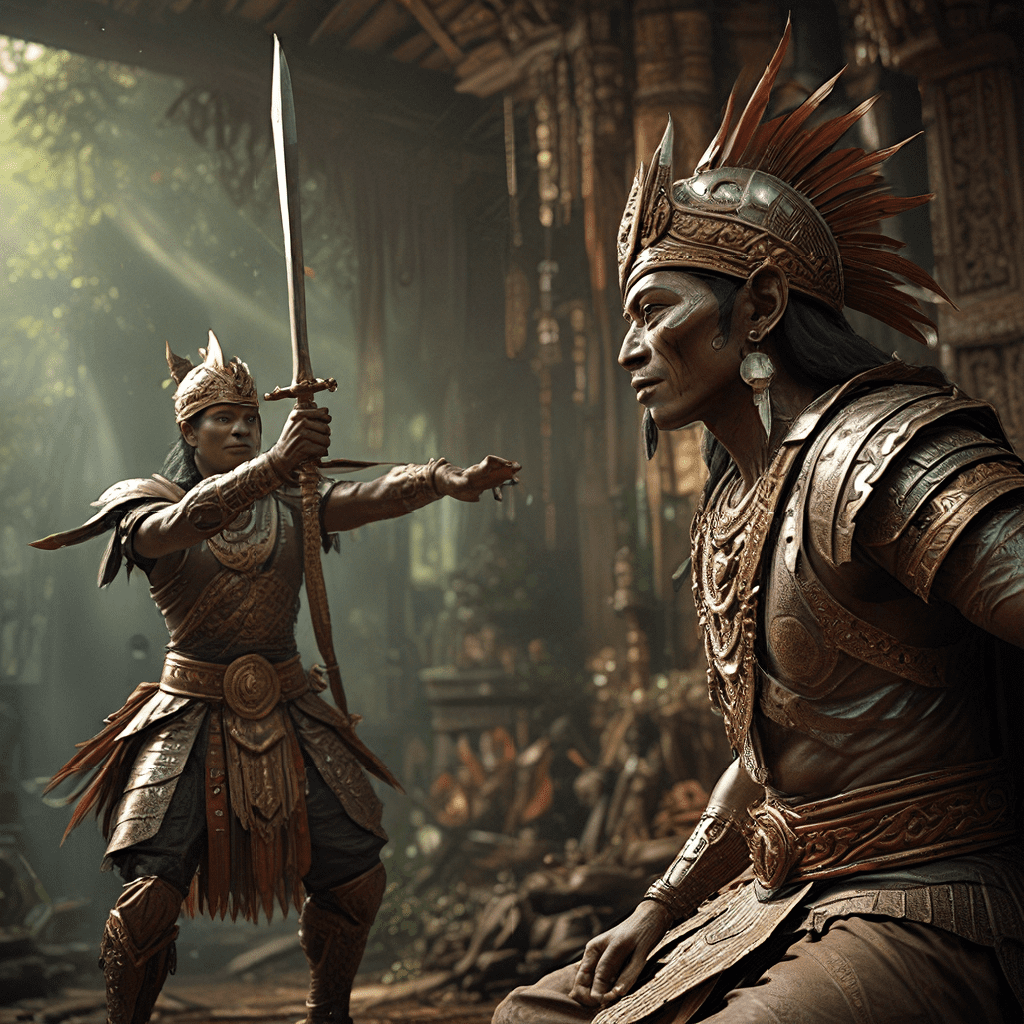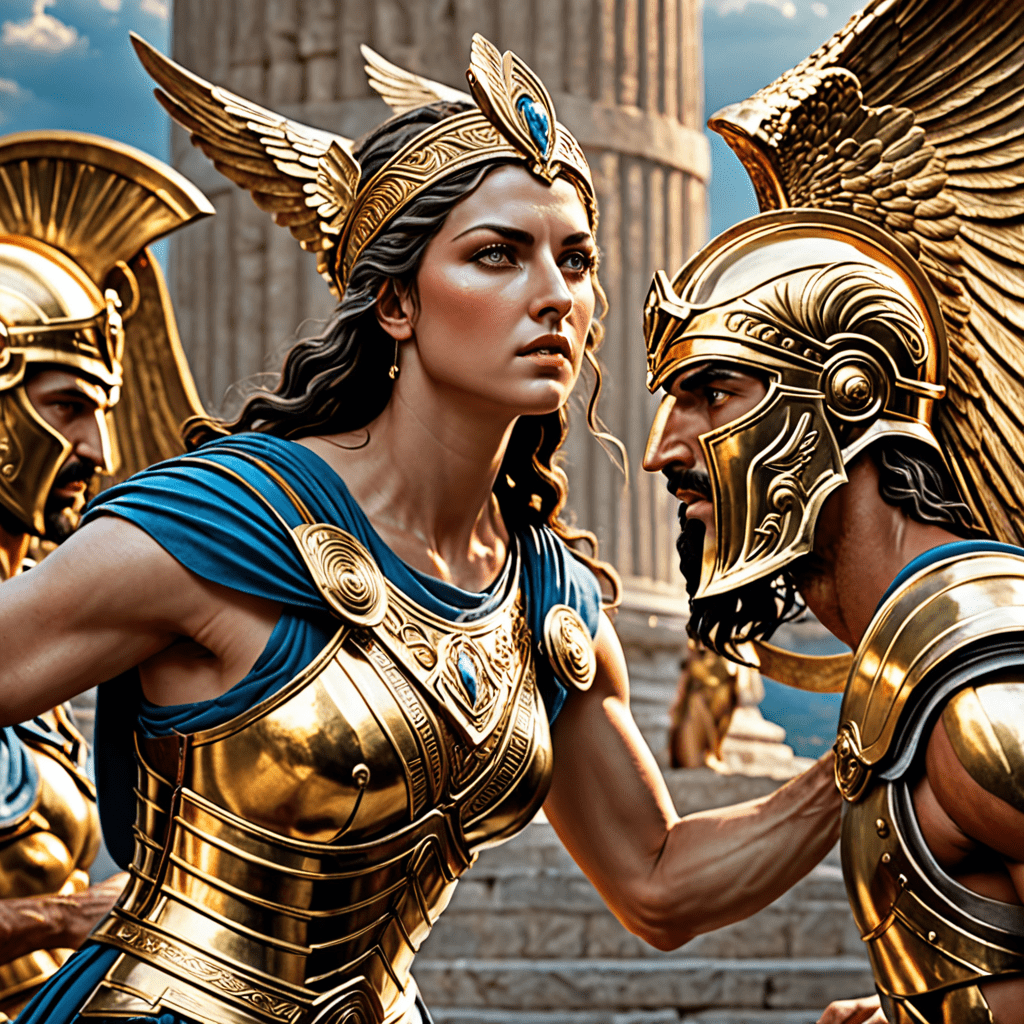Indonesian Folklore: The Power of Mythical Weapons and Artifacts
Indonesia, an archipelago nation with a rich cultural tapestry, is renowned for its vibrant folklore. Woven into the fabric of Indonesian society are captivating tales of mythical weapons and artifacts, objects imbued with supernatural powers and legendary significance. These extraordinary items are not mere figments of imagination but rather deeply rooted in the cultural consciousness, playing a profound role in shaping beliefs, traditions, and the very essence of Indonesian identity.
The Significance of Mythical Weapons and Artifacts in Indonesian Culture
Mythical weapons and artifacts in Indonesian folklore hold immense cultural significance, transcending mere entertainment. They serve as potent symbols, reflecting the aspirations, fears, and values of the people. These objects are often associated with deities, heroes, and powerful figures, underscoring their role in shaping beliefs about the nature of power, destiny, and the spiritual realm. Furthermore, they play a vital role in traditional ceremonies, rituals, and storytelling, serving as a conduit to connect with ancestral wisdom and spiritual forces. The possession of such artifacts can bestow prestige, power, and even divine favor upon their owners, making them highly prized and revered within Indonesian society.
Types of Mythical Weapons in Indonesian Folklore
The realm of Indonesian folklore is teeming with mythical weapons, each possessing unique abilities and significance. These weapons often represent the aspirations and fears of the people, embodying concepts of power, justice, and divine intervention. Among the most iconic and well-known are:
Keris: The Iconic Indonesian Dagger
The keris, a curved dagger with a distinctive wavy blade, is arguably the most iconic weapon in Indonesian folklore. More than just a weapon, the keris is considered a sacred object, believed to possess mystical powers and a connection to the spiritual realm. Its intricate carvings and designs are often imbued with symbolic meanings, representing concepts of power, protection, and even fertility. The keris is a symbol of status, authority, and masculinity, passed down through generations as a cherished heirloom. Its presence in ceremonies, rituals, and traditional arts underscores its deep cultural significance.
Tombak: The Spear of Power and Authority
The tombak, a spear often associated with deities and powerful figures, is another prominent weapon in Indonesian folklore. This weapon represents strength, authority, and the ability to defend against evil forces. Tombaks are frequently depicted in traditional art and literature, symbolizing the power of rulers, warriors, and divine beings. They are often used in rituals and ceremonies, signifying power and protection.
Cundrik: The Divine Throwing Weapon
The cundrik, a small, sharp throwing weapon, is a lesser-known but equally significant weapon in Indonesian folklore. Associated with deities and supernatural beings, the cundrik represents precision, swiftness, and divine retribution. It is believed to be capable of striking with unerring accuracy, often used to defeat evil or protect the innocent. The cundrik is a powerful symbol of divine power and justice, reminding people of the consequences of wrongdoings.
Panah Sakti: The Arrow of Unerring Accuracy
The panah sakti, a magical arrow imbued with supernatural powers, is a weapon often associated with heroes and legendary figures. It is believed to possess the ability to strike targets with pinpoint accuracy, no matter the distance or obstacle. This arrow represents the ultimate weapon of precision, skill, and divine intervention, often used to overcome insurmountable challenges and defeat formidable foes. The panah sakti serves as a reminder of the power of determination, skill, and divine favor in achieving victory.
Mythical Artifacts: Objects of Power and Mystery
Beyond the realm of weapons, Indonesian folklore is rich with mythical artifacts, objects imbued with mystical powers and legendary significance. These artifacts are more than just trinkets; they represent the hopes, fears, and aspirations of the people. They act as conduits to the spiritual realm, serving as symbols of power, protection, and divine favor.
Pusaka: The Sacred Heirlooms of Indonesian Royalty
Pusaka, meaning "heirloom," are sacred objects passed down through generations of Indonesian royalty. These items, often imbued with supernatural powers, symbolize the lineage, authority, and prosperity of the royal family. Pusaka can encompass a wide array of objects, including weapons like keris, jewelry, royal regalia, and even ancient texts. They are believed to hold the spirits of ancestors and can bestow blessings, protection, and good fortune upon their owners. Pusaka play a vital role in royal ceremonies and rituals, reminding people of the historical legacy and spiritual connection that binds generations.
Batu Mustika: Stones of Supernatural Power
Batu mustika, meaning "sacred stones," are stones believed to possess supernatural powers. These stones often exhibit unique colors, patterns, and textures, adding to their mystique. Some batu mustika are said to have originated from sacred sites, volcanic eruptions, or even meteorites. They are associated with various powers, including protection, wealth, healing, and even love. These stones are often worn as amulets or kept in homes for their protective qualities. Their significance lies in their ability to harness the powers of nature and the spiritual world, providing comfort and protection to the people.
Kain Tenun: Woven Fabrics with Hidden Powers
Kain tenun, meaning "woven cloth," are intricately patterned fabrics often imbued with mystical powers. These fabrics are meticulously woven by hand, each thread representing a unique design and symbolism. Kain tenun are often associated with specific regions and communities, reflecting their cultural heritage. Some kain tenun are believed to possess protective qualities, warding off evil spirits or bringing good luck. Others are associated with healing powers or the ability to attract love and prosperity. These fabrics are often worn for ceremonies, rituals, and special occasions, showcasing the intricate craftsmanship and mystical beliefs associated with them.
Theories on the Origins of Mythical Weapons and Artifacts
The existence of these mythical weapons and artifacts in Indonesian folklore raises questions about their origins. While there is no single definitive answer, several theories offer insights into their development.
Animistic Beliefs and Nature Worship
Indonesia's animistic beliefs, which involve the belief that spirits inhabit the natural world, played a significant role in the development of mythical weapons and artifacts. The natural world, including mountains, rivers, and forests, was seen as imbued with spiritual power. Weapons and artifacts made from materials found in nature, like wood, stone, and metal, were believed to absorb and harness this spiritual power. This belief system fostered the creation of objects imbued with supernatural abilities, linking them to the spiritual forces of nature.
Influence of Hindu-Buddhist Mythology
The influence of Hindu-Buddhist mythology, introduced to Indonesia centuries ago, also played a part in shaping the development of mythical weapons and artifacts. Hindu-Buddhist epics like the Ramayana and the Mahabharata feature numerous powerful weapons and artifacts, often associated with deities and heroes. These tales provided inspiration for the development of similar objects in Indonesian folklore, incorporating Hindu-Buddhist concepts of divine power and spiritual significance.
Local Innovation and Cultural Development
Over time, Indonesian cultures developed their unique interpretations of these borrowed concepts, blending them with indigenous beliefs and traditions. This process resulted in the creation of truly unique mythical weapons and artifacts, reflecting the specific cultural contexts and aspirations of different communities. Each region developed its own unique traditions, beliefs, and interpretations of these objects, further enhancing their significance and cultural diversity.
The Role of Mythical Weapons and Artifacts in Indonesian Literature and Performance
Mythical weapons and artifacts are woven into the fabric of Indonesian literature and performance, serving as powerful symbols and storytelling devices. Their presence underscores the enduring influence of folklore on the cultural imagination.
Traditional Tales and Epics
Indonesian folklore is rich with traditional tales and epics that feature mythical weapons and artifacts. These stories often revolve around heroes, villains, and supernatural beings who wield these objects, engaging in epic battles and quests. These tales serve as a vital means of transmitting cultural values, moral lessons, and traditional knowledge. They teach about courage, honor, and the importance of using power responsibly.
Shadow Puppet Plays (Wayang Kulit)
Wayang kulit, a traditional shadow puppet play, is a vibrant and popular form of Indonesian performance art. These plays often feature mythical weapons and artifacts, symbolizing the power, strength, and divine intervention of the characters. Through its intricate storylines and evocative music, wayang kulit offers a platform for exploring the themes of good versus evil, destiny, and the importance of ethical conduct. The captivating imagery of mythical weapons and artifacts adds a layer of mystique and wonder to these performances, engaging the audience's imagination and connecting them to the stories' themes.
Modern Interpretations in Literature and Film
Mythical weapons and artifacts continue to inspire modern Indonesian writers, filmmakers, and artists. They are reimagined and reinterpreted in contemporary literature, films, and even video games, reflecting the enduring appeal of these objects and their ability to resonate with audiences of all ages. These modern interpretations often explore complex themes of power, identity, and the enduring influence of tradition in a rapidly changing world. Through these contemporary works, mythical weapons and artifacts continue to serve as powerful symbols, influencing the cultural imagination and shaping contemporary narratives.
FAQ:
- Are these mythical weapons and artifacts real? While these objects are deeply rooted in Indonesian folklore, they are believed to be infused with mystical powers rather than being actual physical items. However, their importance lies in the symbolic meanings they hold within Indonesian culture.
- How do people use mythical weapons and artifacts today? Today, these objects are often used in traditional ceremonies, rituals, and art forms. They are also frequently depicted in contemporary literature, film, and music, reflecting their enduring influence on Indonesian culture.
- What is the significance of mythical weapons and artifacts in Indonesian culture? These objects serve as potent symbols of power, protection, and spiritual connection. They are deeply woven into Indonesian beliefs, customs, and traditions, representing the hopes, fears, and aspirations of the people.
- Where can I learn more about Indonesian mythical weapons and artifacts? There are numerous books, articles, and websites that delve into the fascinating world of Indonesian mythology, including those focused on mythical weapons and artifacts. You can also explore museums and cultural centers that showcase traditional Indonesian art and artifacts, getting a firsthand glimpse into this rich and diverse cultural heritage.



